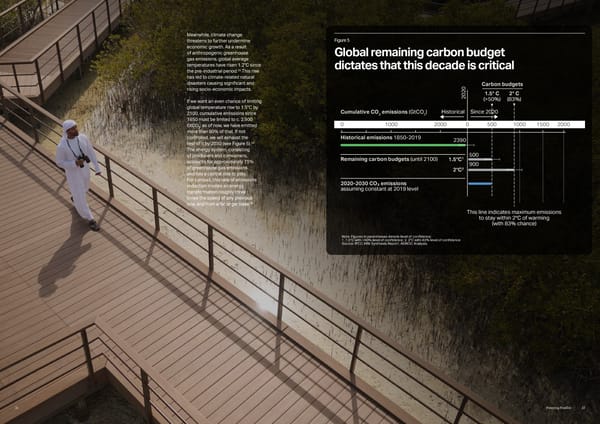Meanwhile, climate change threatens to further undermine economic growth. As a result of anthropogenic greenhouse gas emissions, global average temperatures have risen 1.2°C since the pre-industrial period.33 This rise has led to climate-related natural disasters causing significant and rising socio-economic impacts. If we want an even chance of limiting global temperature rise to 1.5°C by 2100, cumulative emissions since 1850 must be limited to c. 2,900 GtCO2; as of now, we have emitted more than 80% of that. If not controlled, we will exhaust the rest of it by 2030 (see Figure 5).34 The energy system, consisting of producers and consumers, accounts for approximately 75% of greenhouse gas emissions and has a central role to play. For context, this rate of emissions reduction implies an energy transformation roughly three times the speed of any previous one, and from a far larger base.35 Figure 5 Global remaining carbon budget dictates that this decade is critical 2390 2000 Historical Since 2020 2020 Historical emissions 1850-2019 Remaining carbon budgets (until 2100) 2020-2030 CO2 emissions assuming constant at 2019 level 1.5°C1 2°C2 (>50%) (83%) Carbon budgets 0 1000 2000 0 1000 500 1500 500 900 Cumulative CO2 emissions (GtCO2) 1.5° C 2° C This line indicates maximum emissions to stay within 2°C of warming (with 83% chance) Note: Figures in parentheses denote level of confidence; 1. 1.5°C with >50% level of confidence; 2. 2°C with 83% level of confidence Source: IPCC AR6 Synthesis Report; ADNOC Analysis 22 Powering Possible 21
 Powering Possible 2024: AI and Energy for a Sustainable Future Page 11 Page 13
Powering Possible 2024: AI and Energy for a Sustainable Future Page 11 Page 13